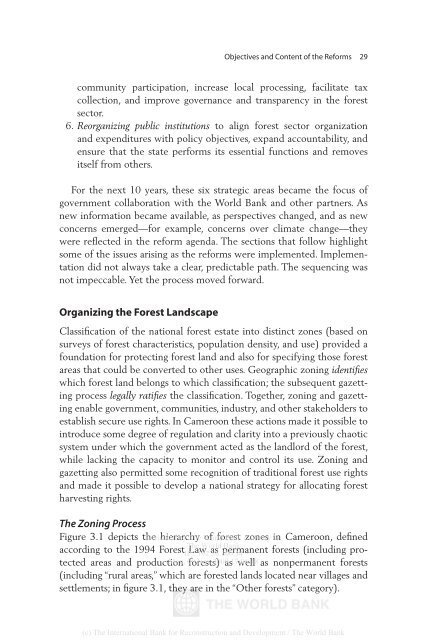The Rainforests of Cameroon - PROFOR
The Rainforests of Cameroon - PROFOR
The Rainforests of Cameroon - PROFOR
- No tags were found...
You also want an ePaper? Increase the reach of your titles
YUMPU automatically turns print PDFs into web optimized ePapers that Google loves.
Objectives and Content <strong>of</strong> the Reforms 29community participation, increase local processing, facilitate taxcollection, and improve governance and transparency in the forestsector.6. Reorganizing public institutions to align forest sector organizationand expenditures with policy objectives, expand accountability, andensure that the state performs its essential functions and removesitself from others.For the next 10 years, these six strategic areas became the focus <strong>of</strong>government collaboration with the World Bank and other partners. Asnew information became available, as perspectives changed, and as newconcerns emerged—for example, concerns over climate change—theywere reflected in the reform agenda. <strong>The</strong> sections that follow highlightsome <strong>of</strong> the issues arising as the reforms were implemented. Implementationdid not always take a clear, predictable path. <strong>The</strong> sequencing wasnot impeccable. Yet the process moved forward.Organizing the Forest LandscapeClassification <strong>of</strong> the national forest estate into distinct zones (based onsurveys <strong>of</strong> forest characteristics, population density, and use) provided afoundation for protecting forest land and also for specifying those forestareas that could be converted to other uses. Geographic zoning identifieswhich forest land belongs to which classification; the subsequent gazettingprocess legally ratifies the classification. Together, zoning and gazettingenable government, communities, industry, and other stakeholders toestablish secure use rights. In <strong>Cameroon</strong> these actions made it possible tointroduce some degree <strong>of</strong> regulation and clarity into a previously chaoticsystem under which the government acted as the landlord <strong>of</strong> the forest,while lacking the capacity to monitor and control its use. Zoning andgazetting also permitted some recognition <strong>of</strong> traditional forest use rightsand made it possible to develop a national strategy for allocating forestharvesting rights.<strong>The</strong> Zoning ProcessFigure 3.1 depicts the Delivered hierarchy by <strong>The</strong> World <strong>of</strong> forest Bank e-library zones in to: <strong>Cameroon</strong>, defined<strong>The</strong> World Bankaccording to the 1994 Forest IP Law : 192.86.100.34 as permanent forests (including protectedareas and production Mon, 09 forests) Nov 2009 as 17:06:18 well as nonpermanent forests(including “rural areas,” which are forested lands located near villages andsettlements; in figure 3.1, they are in the “Other forests” category).(c) <strong>The</strong> International Bank for Reconstruction and Development / <strong>The</strong> World Bank
















